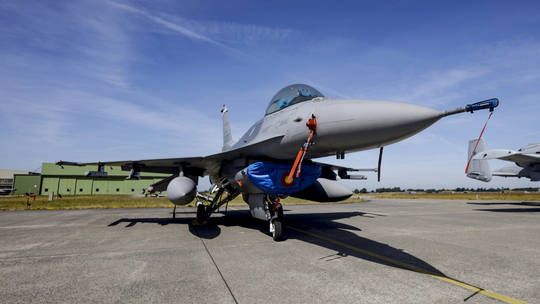
Scott Ritter: Kiev’s broken record: No matter what advanced weaponry the West sends, there is no magic wand to conjure a Ukrainian victory
Keep up to Date & Bypass the Big Tech Censorship
Get uncensored news and updates, subscribe to our daily FREE newsletter!
Zelensky’s team keeps asking for more advanced military hardware as though hoping for a divine intervention that can turn the tide of war
In Japanese, the term Kamikaze, or ‘Divine Wind’, has taken on a dark interpretation, linked as it is to the suicidal pilots who flew their aircraft into enemy ships in the closing months of the Second World War. The original meaning of the phrase, however, was much different, drawn from Japan’s history when, in 1274 and again in 1281, powerful typhoons destroyed the fleets of the invading Mongols, saving the Japanese islands and their people from the wrath of the Mongol leader Kublai Khan.
Ukrainian presidential adviser Mikhail Podoliak appeared to be invoking a modern-day manifestation of the ‘Divine Wind’ of 13th century Japanese history when, in response to a statement made by the Italian Minister of Defense Guido Crosetto, he advocated for a political solution to the ongoing conflict between Russia and Ukraine by calling on the West to provide F-16 fighters, ATACMS long-range artillery rockets, and modern missile and air defense systems to Ukraine.
| Recommended Books [ see all ] | ||||
|---|---|---|---|---|
 |  |  |  |
 |
According to Podoliak, these weapons are needed by Ukraine to forcibly evict Russian forces from territory Ukraine claims is illegally occupied by Russia (including Crimea). Anything less than this, he contends, “will result in the collapse of the global security order and the triumph of bloody cannibals around the world.”
Putting aside Podoliak’s twisted analysis of the political reality on the ground in what Russia today calls Novorossiya, or ‘New Russia’ (the territories of Kherson, Zaporozhye, Donetsk, and Lugansk, which became part of the Russian Federation following referendums held at the end of September 2022), the emphasis placed by the Ukrainian politician on the impact the requested weapons would have on the outcome of the conflict between Russia and Ukraine is telling. On its face, Podoliak’s statement at once reveals the depth of Ukraine’s military difficulties, and the reality that nothing – not even the provision of the requested weapons systems – can reverse the trajectory of strategic defeat that Kiev currently finds itself on.
Back in December 2022, the commander of Ukrainian forces, General Valery Zaluzhny, articulated what material support he wanted from NATO, Western Europe, and the US in order to defeat Russia. “We need tanks,” Zaluzhny said. “We need armored personnel carriers, infantry fighting vehicles. And we need ammo. Please note, I’m not talking about the F-16 now.”
At the end of June 2023, however, Zaluzhny, confronted with the fact that the counteroffensive he had promised if he received the requested weapons (he did) was failing, sang a different tune. “I do not need 120 planes [i.e., F-16’s]. I’m not going to threaten the whole world. A very limited number would be enough. But they are needed. Because there is no other way. Because the enemy is using a different generation of aviation. It’s like we’d go on the offensive with bows and arrows now, and everyone would say, ‘Are you crazy’?”
The US and its NATO allies are currently providing training to Ukrainian pilots on the F-16, and it is expected that Ukraine may receive a small number of the aircraft sometime later this year. But they will not be available in time to have an impact on Ukraine’s faltering counteroffensive, something Zaluzhny believes to be a mistake on the part of his Western partners.
Zaluzhny’s American counterpart, Chairman of the Joint Chiefs of Staff General Mark Milley, disagrees. Following a virtual meeting of the Ukraine Defense Contact Group, which coordinates the supply of weaponry to Ukraine, Milley told the press that the provision of F-16s made no sense from a financial perspective. “If you look at the F-16, 10 F-16s [cost] a billion dollars, the sustainment cost another billion dollars, so you’re talking about $2 billion for 10 aircraft,” Milley said, noting that if the US had provided F-16s earlier, Ukraine would not have gotten much of the equipment Zaluzhny claimed he needed to carry out the Ukrainian counteroffensive. “There are no magic weapons in war,” Milley said. “F-16s are not and neither is anything else.”
Podoliak and the Ukrainians disagree. While hopes for an F-16-powered ‘Divine Wind’ remain quashed for the moment, Kiev is hoping that the US will lift its prohibition on the supply of ATACMS long-range artillery rockets. As things currently stand, however, such a decision is not in the works, with the Biden administration continuing to be worried about any possible escalation in the Ukraine conflict that could lead to a direct military-on-military clash between the US and Russia.
The third ‘Divine Wind’ intervention hoped for by Podoliak is the provision of modern missile and air defense systems to Ukraine. Unfortunately for Podoliak, this question has already been asked and answered, so to speak. Ukraine’s Western partners have poured billions of dollars’ worth of advanced air defense systems into Ukraine, including the US-made Patriot, the German-made IRIS-T, the Spanish-Italian Skyguard/ASPIDE, and the US-Norwegian NASAMS.
The problem facing Ukraine is that Russia has responded to the provisions of these weapons by unleashing a massive suppression of enemy air defense (SEAD) campaign designed to neutralize them, and all of Ukraine’s air defense for that matter. This campaign has been successful at stripping away air defense from the front lines and weakening it around critical strategic targets inside Ukraine. Russia today enjoys air superiority throughout Ukraine, able to strike any target it desires at any time. While Ukraine continues to ask for modern air defense systems to replace those destroyed by Russia, the bottom line is these will suffer the same fate as those that preceded them – being destroyed or rendered ineffective.
Podoliak knows the hard truth, yet he and other senior Ukrainian officials continue to call upon the collective West to provide a miracle weapon that will tip the scales in Ukraine’s favor. In doing so, Podoliak and his fellow countrymen resemble Samuel Beckett’s Vladimir and Estragon in the classic play ‘Waiting for Godot’. Confronted with the reality that Godot (the West) will never come, Podoliak (Vladimir) and his compatriots (Estragon) contemplate suicide, but lack the rope to do the deed. Instead, they talk about getting a rope, only to remain in place, unmoving, waiting for something that will never occur.


